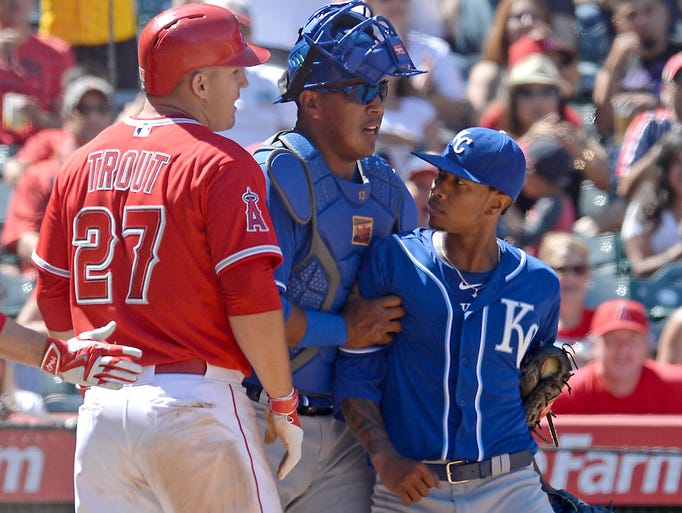Baseball’s culture clash: Vast majority of brawls involve differing ethnicities – USA TODAY
A scene from the Texas Rangers’ clubhouse at Oakland’s Coliseum last week neatly captured the blending of cultures that’s so prevalent in baseball.
As Shin-Soo Choo highlights flashed on a TV screen, a group of seven Latin players sitting around a table – some born in the U.S., others abroad – howled in delight while the Korean outfielder yelled “take that’’ in Spanish at the sight of every line drive.
Baseball teams regularly bring together people from diverse backgrounds striving for a common cause, which in the best of circumstances results in the quintessential melting pot. But when the dynamic changes and the bonding element is replaced by the fire of competition, a different kind of brew arises and sometimes boils over.
A USA TODAY Sports study of 67 bench-clearing incidents in Major League Baseball over the past five seasons found the main antagonists hailed from different ethnic backgrounds in 87% of the cases.
Just more than half of them – 34 – pitted white Americans against foreign-born Latinos. Another four featured white Americans and U.S.-born Latinos.
The figures are startling in a sport where white Americans compose about 60-65% of the population. Based on Opening-day figures, most of the rest is made up of players born outside the U.S. (26.5%) – the vast majority from Latin countries – African Americans (8%) and an undetermined number of Latinos born on U.S. soil.
The season that will conclude Sunday has taken the squabbles to an even higher level, with all 16 bench-clearing instances pitting adversaries of different ethnicity. The Kansas City Royals were involved in four such episodes in the season’s first three weeks, and Dominican-born pitcher Yordano Ventura was a participant in three of them, against Mike Trout, Brett Lawrie (Canadian) and Adam Eaton.
Fritz Polite, former president of the North American Society for the Sociology of Sport and a consultant to the NFL, said that while the institutionalized aspects of baseball are still dominated by whites, the participants have changed.
“Whites still constitute the majority of the league, but there might be frictions with this slow tilt of percentages,’’ Polite said. “It’s not quite tilted yet, but it’s leaning that way.’’
Baseball confrontations often start with a hitter getting plunked, and though there may be several reasons for their high rate among different ethnic groups, many cases point to a culture clash. Baseball has long held to a tradition of unwritten rules of etiquette whose interpretation may vary, with factors such as age and country of origin as part of the mix.
How much is a hitter allowed to “pimp’’ or admire a home run? When is a bat-flip acceptable and when is it offensive? To what extent can a pitcher celebrate getting a big out? What’s the difference between rejoicing over a favorable play and showing up the other team? What kind of actions demand retaliation?
Nobody knows for sure, but there are consequences – typically in the form of a fastball to the ribs or a hard slide – for those who break the code.
“With it being an unwritten rule, there’s unwritten definitions to a celebration or a taunt,’’ said well-traveled outfielder Jonny Gomes, now with the Royals. “It’s in the eye of the beholder.’’
And the application of the rules may depend on which uniform the supposed instigator wears. What irritates an opponents may be deemed amusing or colorful by a teammate.
Houston Astros outfielder Carlos Gomez, a main participant in four dugout-emptying episodes in the last three seasons, is beloved by teammates, who feed off his energy and all-out hustle and defend his right to express himself on the field.
Astros pitcher Dallas Keuchel calls him “personable and probably one of the better teammates I’ve seen.’’
Opponents, on the other hand, often get irked over Gomez’s flamboyant ways. Less than a month after joining the Astros via a July 30 trade with the Milwaukee Brewers, Gomez got into a yelling match with the New York Yankees dugout after displaying frustration over making an out in a blowout.
Gomez, a Dominican native, argues that he doesn’t try to disrespect opponents and notes that he never looks in their direction when celebrating a good deed. He’ll even tip his hat to an opposing pitcher who has done especially masterful work in getting him out.
“Why can a pitcher show you his emotions and you can’t show yours to him? Those are baseball rules from a different time,’’ Gomez told USA TODAY Sports in Spanish. “It gets to the point where, when you’re by yourself, you think, ‘What did I do? I didn’t do anything inappropriate.’ It’s a bit frustrating, because all I’ve ever done is play the game with passion, with desire, with love, giving it my all, and a lot of people take it the wrong way.’’
Count San Diego Padres pitcher Bud Norris among them. In a conversation about what’s proper on-field behavior and what’s not, Norris mentioned Gomez as a particularly egregious violator of the rules. While praising Gomez’s ability, Norris said some of his actions are disrespectful.
When told the large majority of the benches-clearing incidents involved players of different backgrounds, Norris nodded knowingly.
“I think it’s a culture shock,’’ Norris said. “This is America’s game. This is America’s pastime, and over the last 10-15 years we’ve seen a very big world influence in this game, which we as a union and as players appreciate. We’re opening this game to everyone that can play. However, if you’re going to come into our country and make our American dollars, you need to respect a game that has been here for over a hundred years, and I think sometimes that can be misconstrued. There are some players that have antics, that have done things over the years that we don’t necessarily agree with.
“I understand you want to say it’s a cultural thing or an upbringing thing. But by the time you get to the big leagues, you better have a pretty good understanding of what this league is and how long it’s been around.’’
After the episode in New York, Astros manager A.J. Hinch said baseball sometimes gets caught in between wanting to be entertaining and traditional. Those in the latter camp, often veteran players, usually feel compelled to play the role of rules police.
In his final season with the Atlanta Braves, in 2013, Yankees catcher Brian McCann twice confronted opposing players he felt had pimped a home run too much, once Gomez and once Miami Marlins pitcher Jose Fernandez.
San Francisco Giants left-hander Madison Bumgarner, only 26 but already a six-year veteran, has twice this season yelled at hitters – the Los Angeles Dodgers’ Alex Guerrero and the Texas Rangers’ Delino DeShields – simply for acting upset when they popped up against him. The incident with DeShields prompted the dugouts to empty, and Bumgarner wound up exchanging words with Rangers third baseman Adrian Beltre.
Alan Klein, a professor of sociology at Northeastern University in Boston who has written two books on Dominican baseball, said antagonism against a different ethnic group may be harbored within the clubhouse and come out against opponents on the field.
“I think that’s more likely to come from white players than from Latin players,’’ said Klein, speaking generally, not about any specific players. “There are white guys who celebrate exuberantly. But when the guy happens to have slightly darker skin, I think it becomes part of something larger. It’s not just a guy celebrating, it’s a Dominican celebrating.’’
While there’s a certain uniformity to the way the game is played in the U.S., the standards are quite different in other countries. In Korea, for example, bat-flipping is commonplace, without negative repercussions.
In Latin countries, the pros typically play more to the crowd, and actions that are often called “antics’’ in the U.S. are regarded as simply part of the show. Dominican-born reliever Fernando Abad of the Oakland Athletics said players often “dog’’ or taunt each other, but it’s considered fun, not disrespectful.
“Baseball back home is very different than here,’’ Abad said. “In Venezuela it’s the same as in the Dominican, where players gesticulate and point a lot. Fans expect it. They’re used to seeing the players do that. It’s part of the custom.’’
Rangers catcher Chris Gimenez, who has Spanish ancestry but was born and raised in Gilroy, Calif., just south of San Jose, said his experience playing winter ball in the DR and Venezuela was “an eye-opener.’’
The fervor and exuberance he saw made it clear baseball is more than just a game in those countries, and he developed an understanding of what it’s like to grow up in that kind of setting.
“In Latin American countries, baseball is your life,’’ said Gimenez, who does not speak Spanish. “There’s just a love and passion for that, and it shows on the field. To be able to see that and be immersed in the culture and witness it first-hand, it helps you to understand it. I feel like that’s why I have a little bit of a soft spot for it.’’
Gomez would like to hear more sympathetic voices like that, but he’s not about to change how he plays regardless. He might not have developed into a two-time All-Star otherwise. Gomez also points out Latin players are hardly the only ones who display boundless emotion.
AL MVP favorite Josh Donaldson of the Toronto Blue Jays, the A’s Lawrie and Cincinnati Reds second baseman Brandon Phillips stand out as players with a distinctive style. Not surprisingly, they’ve drawn the ire of opponents at times as well. Phillips was one of the main antagonists in the ugly brawls between the Reds and St. Louis Cardinals in August 2010.
Phillips didn’t get thrown at by a pitcher as part of that scuffle, which started when he and Cardinals catcher Yadier Molina exchanged words, but contends he’s a favorite target of opponents. Since his first season with Cincinnati in 2006, Phillips has been hit by 72 pitches, nearly twice as many as the closest Red.
“When they want to hit somebody on our team, they always want to hit me. I know that for a fact,’’ said Phillips, who is African American. “I don’t know why I’m always the one to get hit, but I take it as a compliment. But I don’t like getting hit. It sucks.’’
The purpose pitch remains the weapon of choice for laying down the laws of the game. Gomez, for example, believes it was no accident that lefty Paul Maholm hit him three times before their matchup of Sept. 25, 2013. When Gomez homered off Maholm in that game, he yelled at the pitcher as he rounded the bases, leading to the encounter with McCann.
Gomez defends his actions that day as taking out his frustrations for getting hit, and he says displays of flair and exhilaration have become more accepted over time. But he notes that players’ backgrounds do have an impact on how they approach the game.
The large majority of American players, he points out, have much better educational opportunities than their counterparts born in Latin countries, who often carry the economic survival of their families on their shoulders. That’s how Gomez felt when he first arrived in the U.S. in 2004 as a scared and homesick 18-year-old, desperately missing his relatives but knowing he had to forge ahead without them. That fuels some of the fire he plays with.
“We learn to play the game a different way than they do,’’ Gomez said. “They play the game by the book, and I don’t mean that as a criticism. We learn to play the game with our ability, with our passion. That’s the difference.’’
Contributing: Bob Nightengale, Joe Lemire and Scott Boeck
GALLERY: BENCH-CLEARING INCIDENTS IN 2015







